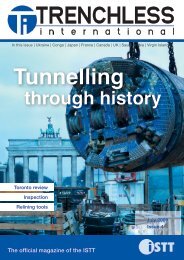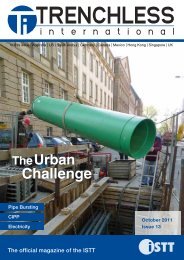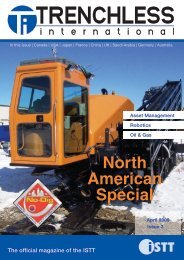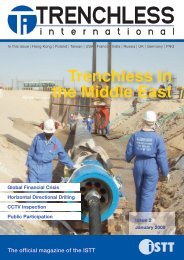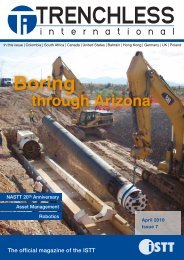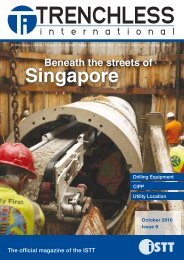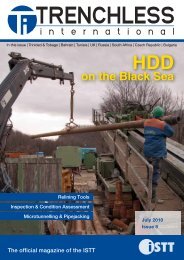tunnel's - Trenchless International
tunnel's - Trenchless International
tunnel's - Trenchless International
Create successful ePaper yourself
Turn your PDF publications into a flip-book with our unique Google optimized e-Paper software.
Working the night shift –<br />
pipe lining in Brussels<br />
In sewer rehabilitation projects, the available window of time for rehabilitation is often the deciding<br />
factor for which method or service provider is chosen. This was demonstrated by a project that<br />
was undertaken in January 2012 in Brussels, Belgium, by KMG Pipe Technologies, the construction<br />
company of SEKISUI Pipe Rehabilitation Europe.<br />
For the overnight rehabilitation of<br />
a 169 m long oval profile of 600/900 mm<br />
a Uniliner system synthetic fibre liner was<br />
employed.<br />
VIVAQUA, the environmental service<br />
provider undertaking the project, is one<br />
of Belgium’s largest suppliers of drinking<br />
water and responsible for operating,<br />
managing and maintaining the southern<br />
sewage disposal system in Brussels’<br />
metropolis. This includes holding<br />
responsibility for undertaking rehabilitation<br />
works on damaged sewers and sewage<br />
systems.<br />
VIVAQUA had to renew one of the<br />
main sections of the Brussels drainage<br />
system, which is located in the district of<br />
Saint-Agatha-Berchem. The concrete oval<br />
profile, running along the Gentsesteenweg<br />
road, had damages requiring rehabilitation<br />
along approximately 600 m of its length.<br />
Due to the state of deterioration of the<br />
pipe, cured-in-place pipe (CIPP) lining was<br />
chosen as the method of pipe renewal.<br />
winding tower. Once the liner was installed<br />
close-fit into the sewer, it was cured by<br />
means of steam injected into the liner by<br />
a truck-mounted generator. Thus, the liner<br />
could actually be cured in the calculated<br />
wall thickness during the Brussels nightshift<br />
– an impressive technical and organisational<br />
feat, which succeeded thanks to close<br />
consultation and smooth co-operation with<br />
the client and the Brussels traffic police.<br />
The police had one special task shortly<br />
before the liner was installed: they ordered<br />
the removal of a 7.5 t lorry, which was parked<br />
above the target shaft for the rehabilitation<br />
work, and supervised the towing away of<br />
the vehicle by the recovery service.<br />
Despite the unforeseen additional step<br />
which caused extra time pressure, the<br />
KMG PT Team was able to successfully<br />
conclude the project for all involved within<br />
the given time frame.<br />
For more news, information and<br />
projects involving CIPP, visit:<br />
CIPP<br />
www.trenchlessinternational.com/resource<br />
‘Brussels steamed sausage’: Employees put the finishing touches to the hermetically sealed end of<br />
the Uniliner that projects from the shaft, before it is subjected to steam and cured within hours.<br />
For more information visit www.sekisui-spr.com<br />
CIPP<br />
October 2012 - <strong>Trenchless</strong> <strong>International</strong><br />
A change in plans<br />
Due to the on-site constraints that<br />
were discovered in the initial phases of<br />
the project, the originally planned method<br />
had to be changed. The drain lay directly<br />
beneath the main traffic artery of the<br />
Belgian capital. Additionally, immediately<br />
above the sewer runs tram tracks,<br />
which are used from early morning until<br />
late evening.<br />
Because of the tramline, the initial idea<br />
of rehabilitating the sewer with a synthetic<br />
fibre liner, using hot water curing, would<br />
not be feasible. The longest individual<br />
section of the 600/900 mm oval profile was<br />
169 m; attempting to cure a pipe of this<br />
length and width using hot water would<br />
have considerably exceeded the permitted<br />
time frame.<br />
Additionally, there were problems with<br />
the construction site facilities. The access<br />
shafts lay underneath the overhead tram<br />
line, so the heavy liner could not be<br />
lifted into the open shaft using a truckmounted<br />
crane.<br />
The 169 m long liner is drawn in via a mobile conveyor.<br />
The drain lay directly beneath the main traffic artery of the<br />
Belgian capital. Additionally, immediately above the sewer<br />
runs tram tracks, which are used from early morning until<br />
late evening.<br />
Another pressing restriction was the time<br />
frame, which was decided by the Brussels<br />
urban transport providers. Construction<br />
site equipment could only be in position<br />
on the route between the last tram of the<br />
day, at 10 pm and the first of the morning,<br />
after 5 am. As a precaution, the current in<br />
the overhead line was switched off during<br />
this time.<br />
A steaming idea<br />
In mid-January 2012 KMG PT in<br />
Belgium suggested the inversion SPR<br />
Europes Uniliner for the project. The liner<br />
is comprised of a synthetic fibre, with an<br />
interior wall thickness of 13.5 mm, and is<br />
cured with steam.<br />
With this technology, the installation team<br />
inverted the liner using a 3.5 m high, mobile<br />
CIPP<br />
October 2012 - <strong>Trenchless</strong> <strong>International</strong><br />
30<br />
31




